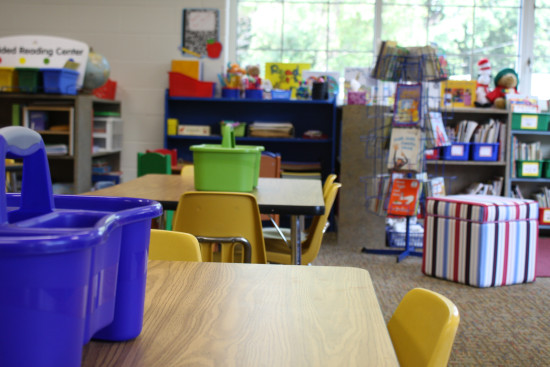
Students stepping into Longfellow Elementary in Rock Island this school year will notice physical changes: a new media center and library, a new cafeteria, and a renovation that has added four new classrooms. But a more important change will be the school's new formal partnership with Augustana College.
The relationship will bring a liberal-arts-based curriculum to Longfellow - a contrast to the No Child Left Behind-forced shift in primary education that emphasizes reading and math skills to the exclusion of other subjects. Though the content of the curriculum will still conform to district standards, the way that content is presented will change: The focus will move to collaboration among students, small-group and individualized instruction, interdisciplinary learning, thematic teaching that attempts to make the coursework relevant, and the fine arts.
A No Child Left Behind-influenced curriculum "doesn't have anything to do with creative problem-solving, imagination, collaboration - all of these skills we need to survive in the next millennium," said Pat Shea, an assistant professor of education at Augustana who was part of the planning team for Longfellow. "If we don't get those things taught, it doesn't matter how many facts we know. ... We are so off-target about what it means to be an educated person, and I think we as educators have the first line of responsibility to start speaking to that."
Investing in Longfellow
In early 2007, Rock Island/Milan School District Superintendent Rick Loy was deciding which elementary schools to close because of the district's declining enrollment and rising costs. Familiar with the informal partnership between Augustana and Longfellow (the schools are less than five blocks apart), Loy approached Augustana President Steven Bahls and asked the college to make a capital investment in the school.
Bahls declined, and in September Loy proposed a partnership without a capital investment. Bahls presented it at a faculty meeting the next day to a warm reception.
The school district and college formed a planning team that in November visited Thomas Metcalf Elementary School, the lab school at Illinois State University. Metcalf is used to model educational methods and theories, and to conduct educational research. During the visit the planning team interviewed faculty members, parents, and students, and saw how teacher candidates can be used in elementary schools. "After we left that place," Loy said, "we were more determined that not only could we make this work, that we will make this work."
In January 2008, the planning committee gave way to a development team of teachers from the Rock Island school district and faculty from the Augustana education department. The group began work on a liberal-arts-based curriculum and eventually helped select the teachers for the new Longfellow.
Moving Beyond Testing
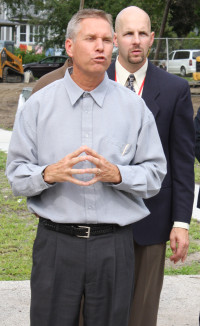 Elementary schools were the last bastions of a holistic education, Loy said, but the "sad reality" of No Child Left Behind is that even primary education has become more test-focused. Instead of providing a well-rounded education with a healthy dose of the fine arts, he said, schools are fixated on making adequate yearly progress in reading and math - the subjects on which students are tested.
Elementary schools were the last bastions of a holistic education, Loy said, but the "sad reality" of No Child Left Behind is that even primary education has become more test-focused. Instead of providing a well-rounded education with a healthy dose of the fine arts, he said, schools are fixated on making adequate yearly progress in reading and math - the subjects on which students are tested.
Longfellow has met its adequate-yearly-progress goals and won the Illinois Spotlight Award - an honor presented to high-poverty schools that are closing the achievement gap - for four consecutive years starting in 2005.
Longfellow Principal Dave Knuckey said he thinks the new partnership will build on the school's already strong test scores. Students "will be able to think for themselves and work out the problems, no matter what problems they face on the test," he said.
Shea, a former elementary-school principal, said test scores might dip initially but should recover within three years. A short-term drop is typical with any new venture, she added. But she emphasized that the success of the new partnership should not be measured in test scores.
"If we are only looking at that one score, we have done a grave disservice to what the whole vision of this project is about, and that is the whole curriculum for the whole child," she said.
Chuck Hyser, Augustana's director of elementary education, coined the phrase "the whole curriculum for the whole child," and uses it to describe the purpose of a Longfellow education. He said the new approach will serve Longfellow students intellectually, physically, and emotionally - a parallel to Augustana's mission of reaching the mind, body, and spirit.
The partnership will most directly affect how things are taught. A liberal-arts curriculum means focusing on connections between subjects instead of divisions, said Augustana Director of Secondary Education Mike Schroeder. "I think we, philosophically, in the department, have a real aversion to an overly structured curriculum that puts up false partitions between the disciplines," he said.
Teachers will use broad themes to emphasize how things are related, and how disparate subjects can inform each other.
For example, students will study the rain cycle in many ways, Shea said - reading about rain, studying changes in rainfall patterns for math, and looking at how countries with little rainfall have been affected for a social-studies component.
Learning Through Experience
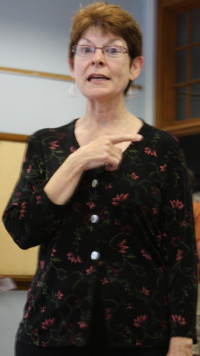 Connections also entail the ways students articulate what they have learned. "How can we express what we learn, not only in writing, but in a drama or in a play?" Shea said.
Connections also entail the ways students articulate what they have learned. "How can we express what we learn, not only in writing, but in a drama or in a play?" Shea said.
The fine arts will be used to reach students who learn best through music and art, said Bill Osborne, the school district's assistant superintendent for instruction and school improvement. Once a principal at Longfellow, he suggested that the new partnership be based in the liberal arts to tap into the entirety of what Augustana has to offer, as opposed to simply the college's education department.
Hyser, who will spend two-thirds of his teaching time working as a liaison between Longfellow and Augustana, plans to add three to four new initiatives every year. The Augustana physics department or club might come to the school to conduct experiments, he said, or the environmental group Global Affect could talk to students about recycling.
He also hopes that as professors at Augustana incorporate more service into the learning experience, they will consider Longfellow as a vehicle. Hyser said that Karin Youngberg, publisher of the East Hall Press at Augustana, has already expressed an interest in having her students collect and publish a volume of Longfellow students' work.
Beyond the liberal arts, a core element of the Longfellow approach comes from the constructivist philosophy of teaching. Schroeder, co-author of Constructivist Methods for the Secondary Classroom: Engaged Minds, said the method involves students learning through experience. They guide their own learning to some extent, becoming practitioners of the discipline they are studying - children studying history become historians, those studying science become scientists, etc.
For Schroeder, constructivism helps students with "the relevance factor" - they get a better understanding of why they're learning what they're learning. Constructivism also places an emphasis on good communication and social skills through collaboration.
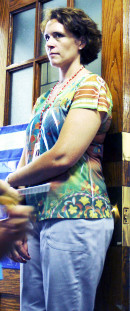 Kim Kettering, a teacher who moved from Horace Mann Choice School to Longfellow, was drawn to Longfellow because of the increased emphasis on constructivism. In her multi-age classroom, students will learn about how civilizations are born and function by creating their own civilization.
Kim Kettering, a teacher who moved from Horace Mann Choice School to Longfellow, was drawn to Longfellow because of the increased emphasis on constructivism. In her multi-age classroom, students will learn about how civilizations are born and function by creating their own civilization.
Multi-age classrooms - the pairing of two consecutive grade levels - aim to improve social skills and student-led learning, and are already in place in other schools in the district. Hyser explained that traditional grades overlap in student ability, and this method presents a more natural learning process. "It is a very comfortable pattern once you are in and used to it," he said.
The hope is that these changes will help move students toward "deep learning ... , deep thinking, ... good problem-solving, and good creativity," Shea said.
"Anytime you can engage the learner to tap into their own creative resources, ... that is obviously going to transfer to higher levels of learning," said Vicki Peterson, a longtime Longfellow kindergarten teacher and member of the development team.
Applying Educational Methods
The partnership will also give Augustana teacher candidates the opportunity to apply the educational concepts they learn.
Augustana professors will teach methods courses in a dedicated classroom at Longfellow, and then give their students - who have not yet done their student teaching - classroom experience.
"We talk sort of idealistically about curriculum, about engaging activities and experiences," Schroeder said. "If you can see that in action someplace and come to believe that it is possible to do some of these things in a real classroom setting, in a real school, I think it makes the experience so much more powerful for the students."
Longfellow teachers will benefit from having more adults to assist with one-on-one and small-group instruction, and also from being exposed to new educational theories and instructional methods.
They will also become partners in the Augustana students' education by helping them understand what went wrong and what went right in the classroom. "It is going to be an opportunity for them to share their experiences and become in essence co-teachers with us," Schroeder said.
Shea, who teaches courses in assessment, sees an added benefit in being able to ask those directly affected by educational models and theories how they feel: "How rich to get to look at it from kids' perspective," she said.
Her students will be able to ask Longfellow students about which assessments they prefer, and also to get a glimpse into how students learn, and how they know they are learning.
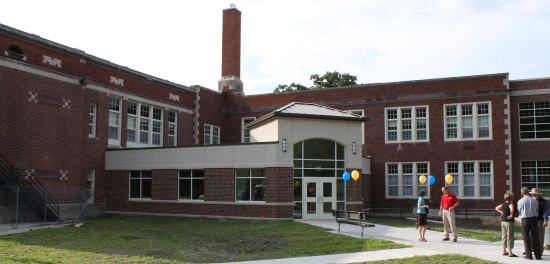
Planting A Seed
As the partnership gets underway, problems inevitably lie ahead. "We see the road, but we have never driven down this road before, so we are not really sure how it is going," Shea said.
Loy stressed that it will take two to three years before the new Longfellow model can be properly evaluated. And Loy knows about these matters; he opened Horace Mann 18 years ago as the first year-round and choice school in the district.
"In my 30 plus years in education, I have learned that it is very difficult to bring dramatic change into the educational system, into the classroom across the district," he said. "If you really want to bring a dramatic change, first of all you need to bring it in pockets - you need to try it one place to see if it works first."
"Nobody has ever heard about ... a partnership that has included the entire institution," Hyser said.
"It is a little seedling that we are planting, and in 10 years' time it is going to be a gorgeous tree with all kinds of branches and leaves growing in ways we would not even imagined," Shea said. "But by tending to it and caring for it, I think it will become a national piece of educational research."










